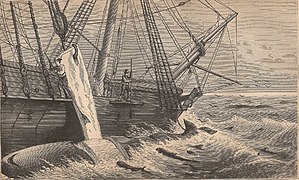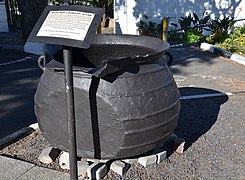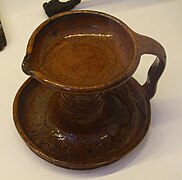Whale Oil

Whale oil is oil obtained from the blubber of whales. Whale oil from the bowhead whale was sometimes known as train oil, which comes from the Dutch word traan ("tear" or "drop").
Sperm oil, a special kind of oil obtained from the head cavities of sperm whales, differs chemically from ordinary whale oil: it is composed mostly of liquid wax. Its properties and applications differ from those of regular whale oil, and it sells for a higher price.
Source and use
Early industrial societies used whale oil in oil lamps and to make soap. In the 20th century it was made into margarine. With the commercial development of the petroleum industry and vegetable oils, the use of whale oils declined considerably from its peak in the 19th century into the 20th century. This is said to have saved whales from extinction. In the 21st century, with most countries having banned whaling, the sale and use of whale oil has practically ceased.
Whale oil was obtained by boiling strips of blubber harvested from whales. The removal is known as "flensing" and the boiling process was called "trying out". The boiling was carried out on land in the case of whales caught close to shore or beached. On longer deep-sea whaling expeditions, the trying-out was done aboard the ship in a furnace known as a trywork and the carcass was then discarded into the water.
Baleen whales were a major source of whale oil. Their oil is exclusively composed of triglycerides, whereas that of toothed whales contains wax esters. The bowhead whale and right whale were considered the ideal whaling targets. They are slow and docile, and they float when killed. They yield plenty of high-quality oil and whalebone, and as a result, they were hunted nearly to extinction.
Chemistry
Whale oil has low viscosity (lower than olive oil), is clear, and varies in color from a bright honey yellow to a dark brown, according to the condition of the blubber from which it has been extracted and the refinement through which it went. It has a strong fishy odor. When hydrogenated, it turns solid and white and its taste and odor change.
The composition of whale oil varies with the species from which it was sourced and the method by which it was harvested and processed. Whale oil is mainly composed of triglycerides (molecules of fatty acids attached to a glycerol molecule). Oil sourced from toothed whales contains a substantial amount of wax esters (especially the oil of sperm whales). Most of the fatty acids are unsaturated. The most common fatty acids are oleic acid and its isomers (18:1 carbon chains).
Whale oil is exceptionally stable.
| Specific gravity | 0.920 to 0.931 at 15.6 °C (60.1 °F) |
| Flash point | 230 °C (446 °F) |
| Saponification value | 185–202 |
| Unsaponifiable matter | 0–2% |
| Refractive index | 1.4760 at 15 °C (59 °F) |
| Iodine number (Wijs) | 110–135 |
| Viscosity | 35–39.6 cSt at 37.8 °C (100.0 °F) |
Applications

The use of whale oil had a steady decline starting in the late 19th century due to the development of superior alternatives, and later, the passing of environmental laws. In 1986, the International Whaling Commission declared a moratorium on commercial whaling, which has all but eliminated the use of whale oil today. The Inuit of North America are granted special whaling rights (justified as being integral to their culture), and they still use whale oil as a food and as lamp oil. See Aboriginal whaling.
Whale oil was used as a cheap illuminant, though it gave off a strong odor when burnt and was not very popular. It was replaced in the late 19th century by cheaper, more efficient, and longer-lasting kerosene. Burning fluid known as camphine was the dominant replacement for whale oil until the arrival of kerosene.
In the US, whale oil was used in cars as a constituent of automatic transmission fluid until it was banned by the 1973 Endangered Species Act. It was also a major component of tractor hydraulic fluid (like the ubiquitous JDM Type 303 Special Hydraulic Fluid) until its withdrawal in 1974.
In the UK, whale oil was used in toolmaking machinery as a high-quality lubricant.
After the invention of hydrogenation in the early 20th century, whale oil was used to make margarine, a practice that has since been discontinued. Whale oil in margarine has been replaced by vegetable oil.
Whale oil was used to make soap. Until the invention of hydrogenation, it was used only in industrial-grade cleansers, because its foul smell and tendency to discolor made it unsuitable for cosmetic soap.
Whale oil was widely used in the First World War as a preventive measure against trench foot. A British infantry battalion on the Western Front could be expected to use 10 gallons of whale oil a day. The oil was rubbed directly onto bare feet in order to protect them from the effects of immersion.
Gallery

Whalers stripping blubber from a whale

Whalers boiling blubber on the deck of their ship (1874 illustration)
Try-pots in Ilulissat, Greenland

Try pot or Blubber Pot seen in Simon's Town in South Africa

Maori cutting up the blubber of beached pilot whales (Te Arai, New Zealand, 1911)

Men boiling the blubber of a beached blackfish at Tokerau Beach. (New Zealand, 1911)

An Inuit woman tending a qulliq, a traditional whale oil lamp (Nunavut, 1999)
Whale oil lamp in brown-glazed earthenware with candle bowl for the wick and base drip pan. Lyse parish, Bohuslän – now in Nordiska museet, Stockholm, Sweden
In literature, fiction, and memoirs
The pursuit and use of whale oil, along with many other aspects of whaling, are discussed in Herman Melville's Moby-Dick (1851). In the novel, the preciousness of the substance to contemporary American society is emphasized when the fictional narrator notes that whale oil is "as rare as the milk of queens." John R. Jewitt, an Englishman who wrote a memoir about his years as a captive of the Nootka people on the Pacific Northwest Coast in 1802–1805, describes how whale oil was used as a condiment with every dish, even strawberries.
Friedrich Ratzel in The History of Mankind (1896), when discussing food materials in Oceania, quoted Captain James Cook's comment in relation to "the Maoris" saying "No Greenlander was ever so sharp set upon train-oil as our friends here, they greedily swallowed the stinking droppings when we were boiling down the fat of dog-fish."
In the 2012 video game Dishonored, whale oil is an important source of power for ships, lighting, weaponry, and the generation of electricity. Which fits with the games fictional but heavily 19th-Century inspired aesthetic.
See also
- Oleochemical
- Rendering (animals)
- Spermaceti
- Sperm oil
- Sperm whaling
- Whaling







